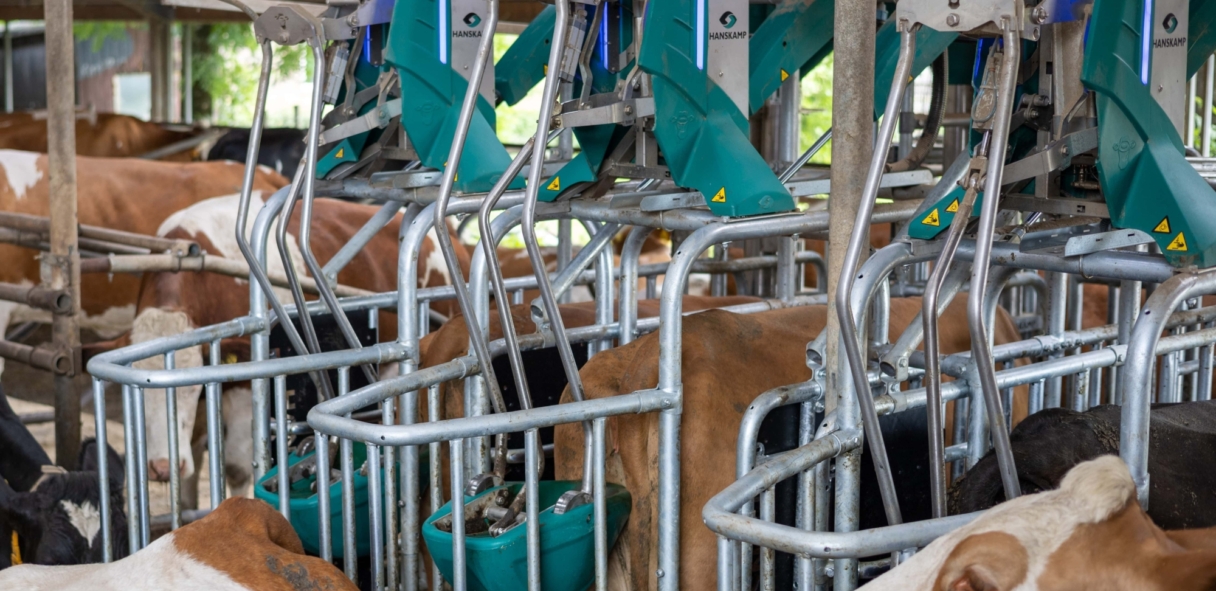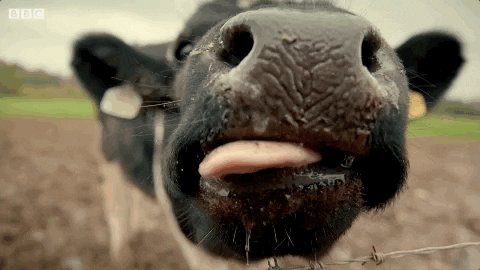
Mateman farm
The collection container moves up and down between the cow’s udder and vulva. This stimulates a urinating reflex. The urine is collected in the container. In the meanwhile, the cow can eat concentrate.
Cows at the Mateman farm regularly use the cow toilet
It certainly takes some getting used to the unusual sight of a cow urinating into a container, but the cows don't seem to mind at all. ‘A combination of factors motivated our decision to invest in feed stations with integrated cow toilets', says Henk Mateman. He runs the farm in partnership with his wife Liesbeth and son Bram. They have a herd of 175 Fleckvieh dairy cows and 80 heads of young stock and have about 60 hectares of land in use.
‘We have quite an intensive operation here, and have to get rid of our manure. That itself is immediately one of the reasons why cow toilets are an interesting proposition for our farm,’ says Bram Mateman. ‘Collecting the urine separately can significantly reduce our costs for manure disposal. It’s expensive to have all the slurry collected. But pure urine is a different matter. It is a valuable form of fertiliser that contains nitrogen and potassium. The horticultural sector is willing to pay for it and can buy it at www.urinebank.nl.’
But the cost of manure disposal wasn't the main reason for Mateman to think about installing cow toilets. Henk Mateman: ‘The seed of the idea was sown by an optimisation plan that Bram created while studying at the Dairy Training Centre in Oenkerk.’ Bram installed cameras in the barn and recorded footage at the feed station for 48 hours.’
‘The footage confirmed our suspicions quite a lot of agitation around the feed stations', he continues. ‘We saw high-ranking cows routinely and roughly force heifers out of the feed station. That made us think. The current feed stations were already 33 years old and there were just four stations for 160 cows; which wasn't really enough. Our veterinarian advised us to choose a design with a gate so the cow in the station could be left to eat in peace.’

Expansion
Another contributing factor was long-standing plans the Mateman family had to expand their cubicle barn. Henk Mateman: ‘We wanted to updadte the old barn in line with the latest requirements. But we can't build due to all the uncertainty surrounding the permits and the lack of an agreement with the government about the future direction of farming. It’s highly likely that we will have to take measures to reduce ammonia emissions once constructing a new barn is possible again. But a low-emission floor is not our preferred solution. This type of floor will increase our costs whereas the CowToilet actually saves us costs for removing our manure. During their search for new feed stations, the Mateman family came into contact with Hanskamp, a company that focuses on producing user friendly technological innovations for the dairy industry.
‘The feed stations from Hanskamp appealed to us as they can be closed. After she has finished eating, a cow can exit the feeder at the front or back as she likes. A benefit for the cows is no longer having to put their heads into a dark space to eat. The concentrate falls into an open feeder so the cow can look around while eating her pellets,’ says Bram Mateman.
But the fact that a cow toilet can be integrated into the feed station was what really caused the light bulb effect for the farmers. ‘As it would also reduce ammonia emissions, we could already anticipate developments affecting a possible expansion of the barn ’, says Henk Mateman. ‘And as collecting the urine separately also reduced our manure disposal costs, the investment in the cow toilets can be recovered. In addition, the phosphates and organic matter are retained for use on our own land. So it’s effectively a revenue model.’
The CowToilet has currently been awarded a provisional emission factor (PEF) of 8.4 kg NH3. At Hanskamp's request

How a cow toilet works
A cow toilet collects urine from a cow while she's eating in the feed station. The CowToilet uses a natural nerve reflex that causes the cow to urinate in a container. This nerve is located under the cow’s skin between the vulva and udder. Once the cow starts urinating, the cow toilet collects the urine and pumps it to a separate urine storage reservoir. In this way, half of all the urine can be collected when the cows are in the barn. A cow produces about 25-30 litres of urine a day, so if organised properly almost 15 litres can be collected in the cow toilet.
Would you like to see the CowToilet in practice? Make an appointment with Hanskamp. On 22 September we are organising a CowToilet and Free Living Barn tour for dairy farmers to visit various trial farms.

Effect of cow toilet can be monitored
The ability to monitor the effect of the cow toilet is a positive aspect for the authorities that issue permits. ‘The system registers everything, such as which cows have used the toilet when and how frequently. We also know exactly how much urine has been collected in the reservoir.’ Tolkamp says that reducing ammonia by separating the urine and faeces at the source is a natural process. ‘The system is simple and involves no chemical additives.’
At the Mateman farm, the six new feed stations with cow toilets have been in use for a few months now. The farmers are satisfied with progress. ‘Compared with the old situation, the barn is really peaceful and calm. We let the cows get used to the feed stations for a few weeks without using the cow toilets. Now, it’s perfectly normal for them to urinate into a container. The amount of urine we collected each day steadily increased. Cows are also creatures of habit. They often start to urinate before the nerve reflex is stimulated.’ The cows now have meadow access for four hours twice a day.
‘That is why we collect a little less urine;
but the faeces and urine in the meadow are also separated, so no ammonia is emitted there.’
The urine collected by the six cow toilets is pumped to a manure cellar. ‘We have a separate manure cellar under the feed aisle that is separate to the other manure storage. That is very handy. We store the urine in that cellar until it is picked up from the farm. We have now collected around 30 cubic metres.’ Henk Mateman hopes the regulations will change in the future so they are permitted to use the urine as a fertiliser replacement on their own farm. ‘It’s rather a paradox that we have to get rid of such a useful fertiliser resource and then buy it back.’
The cow toilets involve hardly any extra work. ‘We spray the containers clean once a week, that’s all.’
Tax deduction
A feed station with a cow toilet costs €25,000 to € 28,000 per station, depending on the situation. ‘That’s about €1,000 per cow. It’s not cheap. If you buy a standard walk-through feed station, the costs are €10,000 to €12,000 per unit. We can recover the extra costs for the cow toilets through manure disposal and precision fertilisation, and hopefully also by being able to build a new barn with a traditional floor in a few years," says Bram Mateman.
‘Luckily, we’ve also had some help from the tax authorities. Because we can make use of the Environmental Investment Allowance (MIA) and the Arbitrary Depreciation of Environmental Investments (Vamil) schemes, we can deduct a percentage of our investment costs from the taxable profit over 2022.






